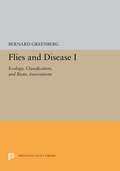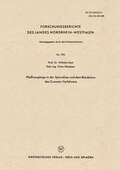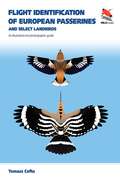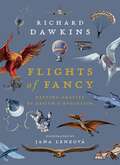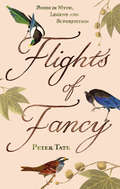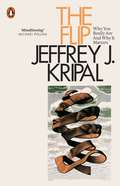- Table View
- List View
Flies and Disease: I. Ecology, Classification, and Biotic Associations (Princeton Legacy Library #5372)
by Bernard GreenbergIn this first volume, Professor Greenberg offers to epidemiologists, medical entomologists, microbiologists, parasitologists, and others concerned with public health and synanthropic and interspecies relationships, a definitive reference work based upon a comprehensive review of the vast studies undertaken during the past 50 years.Originally published in 1971.The Princeton Legacy Library uses the latest print-on-demand technology to again make available previously out-of-print books from the distinguished backlist of Princeton University Press. These editions preserve the original texts of these important books while presenting them in durable paperback and hardcover editions. The goal of the Princeton Legacy Library is to vastly increase access to the rich scholarly heritage found in the thousands of books published by Princeton University Press since its founding in 1905.
Fließbedingung für Stahlbeton mit Berücksichtigung der Betonzugfestigkeit (Institut für Baustatik und Konstruktion #67)
by P. Marti ThürlimannFließgewässer: Hydraulik, Hydrologie, Morphologie und Wasserbau
by Andreas MalcherekDas vorliegende Buch vermittelt Studierenden die hydrologischen, hydraulischen und wasserbaulichen Grundlagen für Gerinne und Fließgewässer. Mit den Programmierbeispielen können die Inhalte geübt und vertieft werden.
Fließgewässer- und Auenentwicklung: Grundlagen und Erfahrungen
by Klaus Arzet Birgit Beckers Walter Binder Hubertus Brückner Holger Brux Dieter Coldewey Alexandra Dehnhardt Ulrich Detering Sebastian Döbbelt-Grüne Joachim Drüke Thomas-Ols Eggers Klaus-Dieter Fröhlich Christian Göldi Josef Groß Anja Kaussow Stephan Von Keitz Ellen Kiel Uwe Koenzen Werner Konold Annette Kurth Roland Loerbroks Helmut Mader Dietmar Mehl Peter Meyer Thomas Paulus Tanja Pottgieser Bernd Schackers Michael Schirmer Jörg Scholle Georg Schrenk Peter Sellheim Mechtild Semrau Mario Sommerhäuser Simon Spinner Eberhard Städtler Bernd Walser Klaus Werk Michael WeyandDieses Fachbuch erläutert die Grundlagen für die Entwicklung von Fließgewässern und Gewässerauen und hilft dabei an den Erfahrungen der Autoren teilzuhaben. Aktuelle Vorgehensweisen zum Umgang mit einer dynamischen Gewässer- und Auenentwicklung werden nachvollziehbar dargestellt und durch zahlreiche Beispiele aus unterschiedlichen Gewässerlandschaften ergänzt. Zur Erreichung der ambitionierten Ziele der Europäischen Wasserrahmenrichtlinie (WRRL) sind die gewässerökologischen, naturschutzfachlichen und hydromorphologischen Bedingungen (u.a. Hoch- und Niedrigwasser) im Gewässerkörper und in den angrenzenden Bereichen (u.a. die Gewässerauen), bei der Planung und Gestaltung zu berücksichtigen. Eine ganzheitliche Betrachtungsweise ist dabei Grundvoraussetzung.
Fließgewässer- und Auenentwicklung: Grundlagen und Erfahrungen
by Peter JürgingNatürliche Fließgewässerlandschaften sind dynamische Abfluss-, Retentions- und Lebensräume. Früher wurden bei Gewässerausbauten diese wichtigen Funktionen meist nicht ausreichend berücksichtigt. Die Folgen sind zum Teil massive Störungen des Wasserhaushaltes, die sich insbesondere auf die Abflüsse (Hoch- und Niedrigwasser) und die morphologischen Gewässerbettstrukturen auswirken, aber auch den Naturhaushalt der Fließgewässer- und Auenlandschaften verändert haben. Konsequenterweise wurden zunehmend Forderungen zum Schutz, zur Wiederherstellung oder Schaffung naturnäherer Verhältnisse in und an Fließgewässern einschließlich ihrer Auen laut. Bei der Konzeption dieses Buches wurde eine ganzheitliche Betrachtungsweise gewählt. Die Eigenschaften (Besonderheiten) von natürlichen Fließgewässerlandschaften werden ebenso erläutert, wie die Auswirkungen von menschlichen Einflüssen auf die Fließgewässerentwicklung. Aktuelle Vorgehensweisen im Zusammenhang mit dynamischen Gewässer- und Auenentwicklungen werden nachvollziehbar dargestellt und durch zahlreiche Beispiele aus unterschiedlichen Gewässerlandschaften ergänzt.
Fließgewässer- und Auenentwicklung: Grundlagen und Erfahrungen
by Heinz PattDieses Fachbuch erläutert die Grundlagen und Erfahrungen bei der Entwicklung von Fließgewässern und Gewässerauen. Aktuelle Vorgehen zum Umgang mit einer dynamischen Gewässer- und Auenentwicklung werden nachvollziehbar dargestellt und durch zahlreiche Beispiele aus unterschiedlichen Gewässerlandschaften ergänzt. Zur Erreichung der ambitionierten Ziele der Europäischen Wasserrahmenrichtlinie sind die gewässerökologischen, naturschutzfachlichen und hydromorphologischen Bedingungen (u.a. Hoch- und Niedrigwasser) im Gewässerkörper und in den angrenzenden Bereichen (u.a. die Gewässerauen), bei der Planung und Gestaltung zu berücksichtigen. Eine ganzheitliche Betrachtungsweise ist dabei Grundvoraussetzung.
Fließvorgänge in der Spinndüse und dem Blaukonus des Cuoxam-Verfahrens (Forschungsberichte des Landes Nordrhein-Westfalen #790)
by Wilhelm KastFlight
by Zack ScottFlight is the story of humankind's most ambitious undertaking. From thousand-year-old flying machines and the trailblazing 'birdmen' who risked their lives to test them, to the Wright brothers' legendary first flight and the iconic spacecraft of the modern era, Flight weaves together the extraordinary history of aviation with an in-depth look at the mechanics of how planes work. Sumptuously illustrated and written by a former RAF technician, this is the definitive guide to how we conquered the skies.
Flight 427: Anatomy of an Air Disaster
by Gerry ByrneBoeing's 737 is indisputably the most popular and arguably the safest commercial airliner in the world. But the plane had a lethal flaw, and only after several disastrous crashes and years of painstaking investigation was the mystery of its rudder failure solved. This book tells the story of how engineers and scientists finally uncovered the defect that had been engineered into the plane. One of its novel features is that it portrays the complex interaction of different experts and opposing interests in investigating and solving the mystery of this single crash.
Flight Dynamics
by Robert F. StengelFlight Dynamics takes a new approach to the science and mathematics of aircraft flight, unifying principles of aeronautics with contemporary systems analysis. While presenting traditional material that is critical to understanding aircraft motions, it does so in the context of modern computational tools and multivariable methods. Robert Stengel devotes particular attention to models and techniques that are appropriate for analysis, simulation, evaluation of flying qualities, and control system design. He establishes bridges to classical analysis and results, and explores new territory that was treated only inferentially in earlier books. This book combines a highly accessible style of presentation with contents that will appeal to graduate students and to professionals already familiar with basic flight dynamics. Dynamic analysis has changed dramatically in recent decades, with the introduction of powerful personal computers and scientific programming languages. Analysis programs have become so pervasive that it can be assumed that all students and practicing engineers working on aircraft flight dynamics have access to them. Therefore, this book presents the principles, derivations, and equations of flight dynamics with frequent reference to MATLAB functions and examples. By using common notation and not assuming a strong background in aeronautics, Flight Dynamics will engage a wide variety of readers. Introductions to aerodynamics, propulsion, structures, flying qualities, flight control, and the atmospheric and gravitational environment accompany the development of the aircraft's dynamic equations.
Flight Dynamics: Second Edition
by Robert F. StengelAn updated and expanded new edition of an authoritative book on flight dynamics and control system design for all types of current and future fixed-wing aircraftSince it was first published, Flight Dynamics has offered a new approach to the science and mathematics of aircraft flight, unifying principles of aeronautics with contemporary systems analysis. Now updated and expanded, this authoritative book by award-winning aeronautics engineer Robert Stengel presents traditional material in the context of modern computational tools and multivariable methods. Special attention is devoted to models and techniques for analysis, simulation, evaluation of flying qualities, and robust control system design.Using common notation and not assuming a strong background in aeronautics, Flight Dynamics will engage a wide variety of readers, including aircraft designers, flight test engineers, researchers, instructors, and students. It introduces principles, derivations, and equations of flight dynamics as well as methods of flight control design with frequent reference to MATLAB functions and examples. Topics include aerodynamics, propulsion, structures, flying qualities, flight control, and the atmospheric and gravitational environment.The second edition of Flight Dynamics features up-to-date examples; a new chapter on control law design for digital fly-by-wire systems; new material on propulsion, aerodynamics of control surfaces, and aeroelastic control; many more illustrations; and text boxes that introduce general mathematical concepts.Features a fluid, progressive presentation that aids informal and self-directed studyProvides a clear, consistent notation that supports understanding, from elementary to complicated conceptsOffers a comprehensive blend of aerodynamics, dynamics, and controlPresents a unified introduction of control system design, from basics to complex methodsIncludes links to online MATLAB software written by the author that supports the material covered in the book
Flight Dynamics Principles: A Linear Systems Approach To Aircraft Stability And Control
by Michael V. CookThe study of flight dynamics requires a thorough understanding of the theory of the stability and control of aircraft, an appreciation of flight control systems and a grounding in the theory of automatic control. Flight Dynamics Principles is a student focused text and provides easy access to all three topics in an integrated modern systems context. Written for those coming to the subject for the first time, the book provides a secure foundation from which to move on to more advanced topics such as, non-linear flight dynamics, flight simulation, handling qualities and advanced flight control.
Flight Dynamics, Simulation, and Control: For Rigid and Flexible Aircraft
by Ranjan VepaExplore Key Concepts and Techniques Associated with Control Configured Elastic AircraftA rapid rise in air travel in the past decade is driving the development of newer, more energy-efficient, and malleable aircraft. Typically lighter and more flexible than the traditional rigid body, this new ideal calls for adaptations to some conventional concep
Flight Dynamics, Simulation, and Control: For Rigid and Flexible Aircraft
by Ranjan VepaFlight Dynamics, Simulation, and Control of Aircraft: For Rigid and Flexible Aircraft explains the basics of non-linear aircraft dynamics and the principles of control-configured aircraft design, as applied to rigid and flexible aircraft, drones, and unmanned aerial vehicles (UAVs). Addressing the details of dynamic modeling, simulation, and control in a selection of aircraft, the book explores key concepts associated with control-configured elastic aircraft. It also covers the conventional dynamics of rigid aircraft and examines the use of linear and non-linear model-based techniques and their applications to flight control. This second edition features a new chapter on the dynamics and control principles of drones and UAVs, aiding in the design of newer aircraft with a combination of propulsive and aerodynamic control surfaces. In addition, the book includes new sections, approximately 20 problems per chapter, examples, simulator exercises, and case studies to enhance and reinforce student understanding. The book is intended for senior undergraduate and graduate mechanical and aerospace engineering students taking Flight Dynamics and Flight Control courses. Instructors will be able to utilize an updated Solutions Manual and figure slides for their course.
Flight Dynamics, Simulation, and Control: For Rigid and Flexible Aircraft
by Ranjan VepaFlight Dynamics, Simulation, and Control of Aircraft: For Rigid and Flexible Aircraft explains the basics of non-linear aircraft dynamics and the principles of control-configured aircraft design, as applied to rigid and flexible aircraft, drones, and unmanned aerial vehicles (UAVs). Addressing the details of dynamic modeling, simulation, and control in a selection of aircraft, the book explores key concepts associated with control-configured elastic aircraft. It also covers the conventional dynamics of rigid aircraft and examines the use of linear and non-linear model-based techniques and their applications to flight control. This second edition features a new chapter on the dynamics and control principles of drones and UAVs, aiding in the design of newer aircraft with a combination of propulsive and aerodynamic control surfaces. In addition, the book includes new sections, approximately 20 problems per chapter, examples, simulator exercises, and case studies to enhance and reinforce student understanding. The book is intended for senior undergraduate and graduate mechanical and aerospace engineering students taking Flight Dynamics and Flight Control courses. Instructors will be able to utilize an updated Solutions Manual and figure slides for their course.
Flight Identification of European Passerines and Select Landbirds: An Illustrated and Photographic Guide (WILDGuides #37)
by Tomasz CoftaA richly illustrated, state-of-the-art field guide for identifying European passerines in flight—the first of its kindOpening up new frontiers in birdwatching, this is the first field guide to focus specifically on the identification of European passerines and related landbirds in flight. Showcasing 850 stunning and remarkably lifelike colour illustrations from acclaimed bird artist Tomasz Cofta, produced using the latest digital technology, backed up with more than 2,400 photographs carefully selected to show typical flight profiles, it provides detailed and unsurpassed coverage of 205 European passerines and 32 near-passerines. This cutting-edge book brings a new dimension to birdwatching, the concise and authoritative species accounts presenting novel yet essential information on the flight manner of individual birds and the structure and behaviour of flocks—features that are key to identification. It also includes precise transliterations of flight calls, supported by sonograms, and links to a unique collection of hundreds of online audio recordings. Beautifully designed and written in an accessible style, this book will appeal to birdwatchers of all abilities. It presents the latest knowledge on flight identification of a group of birds that is poorly covered in the literature and is therefore a must-have for all professional ornithologists and scientists involved in migration studies.The first field guide to flight identification of European passerines and related landbirdsCovers 205 European passerines and 32 near-passerinesFeatures 850 stunning colour illustrationsIncludes more than 2,400 photos showing typical profiles of each species in flightProvides detailed information on flight calls, with links to online recordings
The Flight of a Relativistic Charge in Matter: Insights, Calculations and Practical Applications of Classical Electromagnetism (Lecture Notes in Physics #1014)
by Wade AllisonThis book is about the energy loss and the coherent radiation emitted by a relativistic charge in matter. These phenomena – locally deposited energy, Cherenkov radiation and transition radiation – are the basis of any charged particle detector able to discriminate charges by their velocity. This book describes these phenomena and how they are related. The fundamental field equations and first principles are used to derive the spectrum of energy-loss signals and thence the velocity resolution that can be achieved. Two specific applications are then followed: the first shows that this resolution has been achieved in practice with a multi-particle detector in the course of an experiment at CERN, and the second shows how, by including scattering, the technique of ionisation cooling of accelerator beams may be reliably simulated. The book is based on a series of lectures given at the University of Oxford to graduate students in experimental particle physics. Some knowledge of mathematical physics at an undergraduate level is assumed, specifically Maxwell’s equations and classical optics.
Flight of Mammals: From Terrestrial Limbs to Wings
by Aleksandra A. Panyutina Leonid P. Korzun Alexander N. KuznetsovThis book offers a new explanation for the development of flight in mammals and offers detailed morphological descriptions of mammals with flapping flight. The skeletomuscular apparatus of the shoulder girdle and forelimbs of tree shrews, flying lemurs and bats is described in detail. Special attention is paid to the recognition of peculiar features of the skeleton and joints. For the basic locomotor patterns of flying lemurs and bats, the kinematic models of the shoulder girdle elements are developed. The most important locomotor postures of these animals are analyzed by means of statics. The key structural characters of the shoulder girdle and forelimbs of flying lemurs and bats, the formation of which provided transition of mammals from terrestrial locomotion to gliding and then, to flapping flight, are recognized. The concept is proposed that preadaptations preceding the acquisition of flapping flight could have come from widely sprawled forelimb posture while gliding from tree to tree and running up the thick trunks. It is shown that flying lemur is an adequate morphofunctional model for an ancestral stage of bats. The evolutionary ecomorphological scenario describing probable transformational stages of typical parasagittal limbs of chiropteran ancestors into wings is developed.
Flightless Birds (Greenwood Guides to the Animal World)
by Clive RootsWe share the earth with a wide variety of animal species, each of which brings something special to the diversity of the planet. By knowing more about how animals behave and live, we gain a greater understanding of how life evolved and the importance of biodiversity. This volume provides a complete guide to those birds that have evolved a trait that would seem to harm their ability to survive - flightlessness. Flight has its advantages - why would some birds be flightless? Flightless Birds covers the loss of flight in birds, both permanently after years of evolution, and temporarily as a result of unusual molting behavior, and those species that are in various stages of losing their flight. The book provides a thorough guide, perfect for research papers in biology classes, for understanding the behavior and biodiversity of a fascinating and unusual group of animals.Flightless Birds includes sections on the major groups of flightless birds: Rarities whose ancient ancestors were on the continents when they broke away millions of years ago, and who survived despite competing with mammals; birds that were marooned on islands in the ocean, where food was plentiful and predators absent; penguins, which evolved alongside seas teeming with food and had no need to fly, and the special case of New Zealand's many flightless species which evolved in a predator-free paradise but could not cope with the settlers and their alien animals; and the many species which have become extinct within historic times. Beautifully illustrated, with numerous color photos, Flightless Birds provides copious material for understanding these unusual animals.
Flights of Fancy: Defying Gravity by Design and Evolution
by Richard DawkinsRichard Dawkins on how nature and humans have learned to overcome the pull of gravity and take to the skies. 'A masterly investigation of all aspects of flight, human and animal... A beautifully produced book that will appeal across age groups' Alexander McCall Smith 'Dawkins has always been an extraordinarily muscular, persuasive thinker. What feels new here is that he writes with such charm and warmth' The TimesHave you ever dreamt you could fly? Or imagined what it would be like to glide and swoop through the sky like a bird? Do you let your mind soar to unknown, magical spaces? Richard Dawkins explores the wonder of flight: from the mythical Icarus, to the sadly extinct but spectacular bird Argentavis magnificens, from the Wright flyer and the 747, to the Tinkerbella fairyfly and the Peregrine falcon. But he also explores flights of the mind and escaping the everyday – through science, ideas and imagination. Fascinating and beautifully illustrated, this is a unique collaboration between one of the world's leading scientists and a talented artist.
Flights of Fancy: Birds in Myth, Legend and Superstition
by Peter TateDid you know that Barnacle geese were once classified as fish? That both the Cherokees and the ancient Greeks were convinced that cranes regularly fought battles with pygmies? That the Swiss believed that any cuckoo that managed to survive for a year would turn into an eagle?Throughout history, birds have fascinated and intrigued mankind, so it is hardly surprising that an astonishingly rich body of myth, legend and superstition has grown up around them. Flights of Fancy explores the stories told about 30 of the world's best-known species, from the blackbird to the wryneck, drawing on traditions from every quarter of the globe. Some of the stories included clearly arose as a result of faulty observation, such as the widely held belief that nightjars sucked milk from cows. Others stemmed from attempts to explain unusual aspects of appearance or behaviour. But the vast majority seem to have their origins in people's delight in inventing stories - whether the legend that the blackbird was originally white, or the suggestion that witches kept owls as their familiars. And, as Peter Tate points out, what is so extraordinary is that the same story often crops up in many different parts of the world: the belief that eagles and snakes are sworn enemies can be found as far apart as Iraq and Mexico; the view that the raven is the harbinger of bad luck can be found throughout Europe from Denmark to Spain.A fascinating and wonderfully entertaining read, this is the ideal book for anyone interested in birds or myths - or both.
Flinovia - Flow Induced Noise and Vibration Issues and Aspects: A Focus on Measurement, Modeling, Simulation and Reproduction of the Flow Excitation and Flow Induced Response
by Elena Ciappi Sergio De Rosa Francesco Franco Jean-Louis Guyader Stephen A. HambricFlow induced vibration and noise (FIVN) remains a critical research topic. Even after over 50 years of intensive research, accurate and cost-effective FIVN simulation and measurement techniques remain elusive. This book gathers the latest research from some of the most prominent experts in the field.It describes methods for characterizing wall pressure fluctuations, including subsonic and supersonic turbulent boundary layer flows over smooth and rough surfaces using computational methods like Large Eddy Simulation; for inferring wall pressure fluctuations using inverse techniques based on panel vibrations or holographic pressure sensor arrays; for calculating the resulting structural vibrations and radiated sound using traditional finite element methods, as well as advanced methods like Energy Finite Elements; for using scaling approaches to universally collapse flow-excited vibration and noise spectra; and for computing time histories of structural response, including alternating stresses.This book presents the proceedings of the First International Workshop on Flow Induced Noise and Vibration (FLINOVIA), which was held in Rome, Italy, in November 2013. The authors’ backgrounds represent a mix of academia, government, and industry, and several papers include applications to important problems for underwater vehicles, aerospace structures and commercial transportation. The book offers a valuable reference guide for all those working in the area of flow-induced vibration and noise.
Flinovia—Flow Induced Noise and Vibration Issues and Aspects-II: A Focus on Measurement, Modeling, Simulation and Reproduction of the Flow Excitation and Flow Induced Response
by Elena Ciappi Sergio De Rosa Francesco Franco Jean-Louis Guyader Stephen A. Hambric Randolph Chi Leung Amanda D. HanfordThis is the proceedings of the Second International Workshop on Flow Induced Noise and Vibration (FLINOVIA), which was held in Penn State, USA, in April 2016. The authors’ backgrounds represent a mix of academia, government, and industry, and several papers include applications to important problems for underwater vehicles, aerospace structures and commercial transportation. The book offers a valuable reference guide for all those working in the area of flow-induced vibration and noise.Flow induced vibration and noise (FIVN) remains a critical research topic. Even after over 50 years of intensive research, accurate and cost-effective FIVN simulation and measurement techniques remain elusive. This book gathers the latest research from some of the most prominent experts in the field.The book describes methods for characterizing wall pressure fluctuations, including subsonic and supersonic turbulent boundary layer flows over smooth and rough surfaces using computational methods like Large Eddy Simulation; for inferring wall pressure fluctuations using inverse techniques based on panel vibrations or holographic pressure sensor arrays; for calculating the resulting structural vibrations and radiated sound using traditional finite element methods, as well as advanced methods like Energy Finite Elements; for using scaling approaches to universally collapse flow-excited vibration and noise spectra; and for computing time histories of structural response, including alternating stresses.
Flinovia—Flow Induced Noise and Vibration Issues and Aspects-III
by Elena Ciappi Sergio De Rosa Francesco Franco Stephen A. Hambric Randolph C. K. Leung Vincent Clair Laurent Maxit Nicolas TotaroThis volume gathers the latest advances and innovations in the field of flow-induced vibration and noise, as presented by leading international researchers at the 3rd International Symposium on Flow Induced Noise and Vibration Issues and Aspects (FLINOVIA), which was held in Lyon, France, in September 2019. It explores topics such as turbulent boundary layer-induced vibration and noise, tonal noise, noise due to ingested turbulence, fluid-structure interaction problems, and noise control techniques. The authors’ backgrounds represent a mix of academia, government, and industry, and several papers include applications to important problems for underwater vehicles, aerospace structures and commercial transportation. The book offers a valuable reference guide for all those interested in measurement, modelling, simulation and reproduction of the flow excitation and flow induced structural response.
The Flip: Who You Really Are and Why It Matters
by Jeffrey J. Kripal'Mindblowing' Michael PollanWhy do we know so much more about the cosmos than our own consciousness? Are there limits to the scientific method? Why do we assume that only science, mathematics and technology reveal truth?The Flip shows us what happens when we realise that consciousness is fundamental to the cosmos and not some random evolutionary accident or surface cognitive illusion; that everything is alive, connected, and 'one'. We meet the people who have made this visionary, intuitive leap towards new forms of knowledge: Mark Twain's prophetic dreams, Marie Curie's séances, Einstein's cosmically attuned mind. But these forms of knowledge are not archaic; indeed, they are essential in a universe that has evolved specifically to be understandable by the consciousnesses we inhabit.The Flip peels back the layers of our beliefs about the world to reveal a visionary, new way of understanding ourselves and everything around us, with huge repercussions for how we live our lives. After all, once we have flipped, we understand that the cosmos is not just human. The human is also cosmic.
